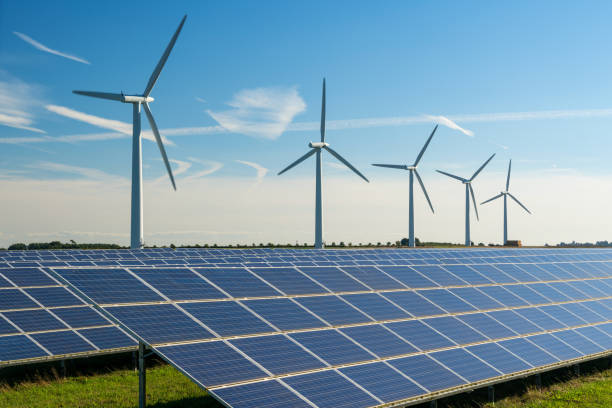Wind energy has several advantages, which is why it is one of the world’s fastest-growing energy sources. Research activities are targeted at resolving the barriers to increased wind energy utilization. Continue reading to discover more about the advantages of wind power and some of the problems it is attempting to solve.
What Is Wind Energy?
Wind energy is a renewable energy that captures wind energy via the use of wind turbines, which turn it into electricity. Wind is produced by the sun as a result of temperature variations. Wind is produced by the uneven heating of the atmosphere, mountains, valleys, and the rotation of the planets around the sun.
Wind Energy’s Advantages and Drawbacks
Wind energy, like all other kinds of renewable energy, has advantages and drawbacks. Certain renewable energy perform better in different parts of the world for various reasons and under different conditions. That’s why it’s important for consumers to know which works best for their part of the country.
Wind Energy’s Advantages
- Wind energy is inexpensive.
After the production tax credit, land-based utility-scale wind is one of the most affordable energy sources accessible today, costing 1-2 cents per kilowatt-hour. Because the power from wind farms is sold at a fixed price over a long period of time (e.g. 20+ years) and its fuel is free, wind energy mitigates the price volatility that fuel prices contribute to traditional sources of energy.
- Wind generates employment.
The wind industry in the United States employs over 100,000 people, and wind turbine technician is one of the fastest growing vocations in the country. Wind has the potential to provide more than 600,000 employment in manufacturing, installation, maintenance, and related services by 2050, according to the Wind Vision Report.
- Wind facilitates industrial growth and competitiveness in the United States to get wind energy.
New wind projects account for yearly investments of over $10 billion in the U.S. economy. The United States has abundant domestic resources and a highly qualified workforce, and it is capable of competing worldwide in the clean energy economy.
- It’s a clean fuel source.
Wind energy does not contaminate the air in the same way as power plants that use fossil fuels, such as coal or natural gas, do, emitting particulate matter, nitrogen oxides, and sulfur dioxide, which cause human health issues and economic harm. Wind turbines emit no acid rain, pollution, or greenhouse gases into the atmosphere.
- Wind is a home energy source.
The nation’s wind resource is abundant and endless. Wind power capacity in the United States has expanded at a rate of 15% per year over the last decade, and it is currently the greatest source of renewable energy in the country.
- It is long-term.
Wind energy is a kind of solar energy. Winds are generated by the sun’s heating of the atmosphere, the Earth’s rotation, and surface imperfections. For as long as the sun shines and the wind blows, the energy created may be captured to transfer power throughout the grid.
- Windmills can be installed on existing farms or ranches in wind energy.
This has a significant economic impact on rural areas, which have the majority of the best wind sites. Farmers and ranchers may continue to work the land because wind turbines take up just a small portion of it. Wind power plant owners pay rent to farmers and ranchers for the use of their property, bringing additional revenue to landowners.
Wind Energy’s Drawbacks
Although wind energy is a sustainable and environmentally friendly energy source, it does have drawbacks and restrictions.
- Dangerous to Some Wildlife
Wind turbines for wind energy are recognized to be hazardous to animals. Flying birds and bats whose homes or migratory pathways might be harmed or killed if they run into the blades that revolve on the fanlike structure of wind turbines as they are spinning. The deaths of birds and bats at wind farm sites have sparked controversy among fish and animal conservation groups. Aside from wildlife that flies in the air, animals on the ground may be harmed by noise pollution caused by whirring blades of wind energy. Although wind turbines can be harmful to animals, other structures such as skyscrapers and enormous windows are similarly dangerous and continue to be constructed without inquiry.
- Noisy from getting wind energy
Wind turbines may be rather noisy, which is why they are generally located in remote places with few people. Noise isn’t a concern depending on where the turbine is located, such as offshore. With technological developments, modern designs have been demonstrated to lessen noise issues and offer a considerably quieter presence for wind energy.
- High Initial Investment
As you might expect, these gigantic buildings are frequently hundreds of feet tall and demand a significant initial investment. Wind turbine installation in rural locations necessitates additional investment in underground lines to transport power to more populous areas such as towns and cities.The early installation and constructing stages are the most expensive, but wind energy creates an infinite supply of electricity as long as there is wind.
- Untrustworthy/Unpredictable
Wind energy suffers from what is known as intermittency, which is a disturbance produced by the wind’s unreliability. Because wind may blow at different speeds, predicting how much energy it can capture at any particular time is difficult. This implies that providers and cities must have an energy reserve or alternate sources of electricity in case the winds fail for an extended period of time.

Conclusion:
As technology advances, so will our options for renewable energy. wind energy is a straightforward energy alternative that we provide as an add-on to our energy programs. When you pick green energy solutions such as wind energy, you are balancing your energy use with renewable energy credits derived from renewable sources such as wind, hydro, and solar energy.
